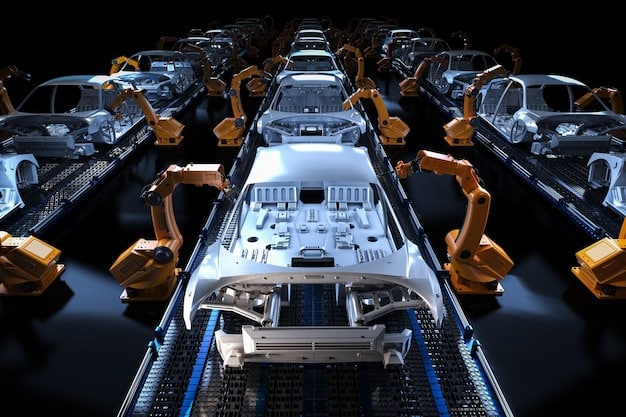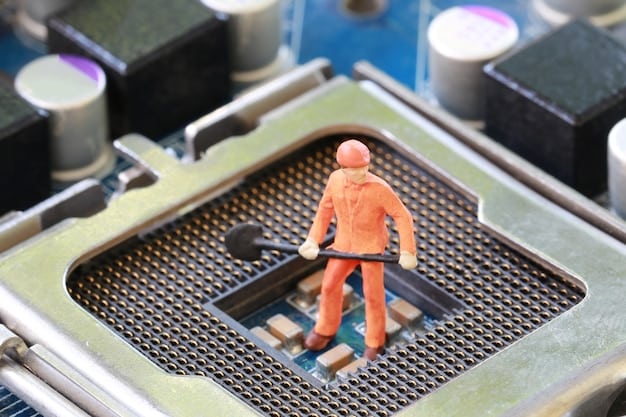US Robotics: Innovations Transforming Manufacturing and Healthcare

The Latest Innovations in US Robotics are revolutionizing both manufacturing and healthcare, enhancing efficiency, precision, and patient care through automation and advanced technologies.
The relentless march of technology has ushered in a new era for robotics in the United States, impacting industries from manufacturing to healthcare. Get ready to explore the latest groundbreaking **The Latest Innovations in US Robotics: From Manufacturing to Healthcare** that are shaping our future.
Robotics in US Manufacturing: The Forefront of Automation
The US manufacturing sector has long been a proponent of automation, but recent advancements in robotics have taken efficiency and precision to unprecedented levels. These innovations aren’t just about replacing human labor; they’re about augmenting it, creating safer workplaces, and enabling the production of increasingly complex goods.
Collaborative Robots (Cobots): Working Hand-in-Hand
One of the most significant shifts in manufacturing robotics has been the rise of collaborative robots, or cobots. These robots are designed to work alongside humans, sharing workspaces and assisting with tasks that are either too dangerous or too repetitive for human workers.
AI-Powered Robotics: Smarter Automation
The integration of artificial intelligence (AI) into manufacturing robotics has opened up new possibilities for automation. AI-powered robots can learn from experience, adapt to changing conditions, and even anticipate potential problems.
- Enhanced precision and speed in assembly lines
- Improved quality control through automated inspection systems
- Predictive maintenance to minimize downtime
- Optimized supply chain management with robotic logistics

These advancements are not just theoretical. Companies across the US are already implementing these innovations to boost productivity, reduce costs, and improve worker safety. The future of US manufacturing is undeniably intertwined with the continued development and deployment of advanced robotics.
Robotics in US Healthcare: Revolutionizing Patient Care
Robotics is also transforming the healthcare industry in the United States, offering new possibilities for diagnosis, treatment, and patient care. From surgical robots to assistive devices, these technologies are enhancing precision, reducing invasiveness, and improving outcomes.
Surgical Robotics: Precision and Minimally Invasive Procedures
Surgical robots have become increasingly prevalent in US hospitals, allowing surgeons to perform complex procedures with greater precision and control. These systems often feature minimally invasive techniques, resulting in smaller incisions, reduced pain, and faster recovery times for patients.
Rehabilitation Robotics: Restoring Movement and Function
Rehabilitation robotics plays a crucial role in helping patients recover from injuries, strokes, and other conditions affecting their mobility. These devices provide targeted assistance and feedback, enabling patients to regain strength, coordination, and independence.
- Robotic prosthetics for enhanced mobility and dexterity
- Exoskeletons for assisting patients with spinal cord injuries
- Robotic therapy for stroke rehabilitation
- Automated medication dispensing systems for improved accuracy
The use of robotics in healthcare is not without its challenges, including high costs and the need for specialized training. However, as technology continues to advance and become more accessible, these barriers are gradually being overcome.
Advanced Materials and US Robotics: Enabling New Capabilities
The development of advanced materials is playing a crucial role in the ongoing evolution of robotics in the United States. These materials are enabling the creation of robots that are lighter, stronger, and more capable than ever before.
Lightweight Composites: Enhancing Agility and Efficiency
Lightweight composite materials, such as carbon fiber and advanced polymers, are being used to reduce the weight of robotic arms and frames. This allows robots to move more quickly and efficiently, while also reducing energy consumption.
Shape Memory Alloys: Versatile Actuation and Sensing
Shape memory alloys (SMAs) are materials that can change shape in response to changes in temperature or electrical current. This property makes them ideal for use in robotic actuators and sensors, enabling more precise and responsive movements.

The ongoing research and development of advanced materials are essential for pushing the boundaries of robotics technology. By enabling the creation of robots with improved performance and capabilities, these materials are helping to drive innovation across a wide range of industries.
AI and Machine Learning in US Robotics: The Rise of Autonomous Systems
Artificial intelligence (AI) and machine learning (ML) are transforming the way robots operate in the United States, enabling them to perform tasks autonomously and adapt to changing environments. This is leading to the development of increasingly sophisticated and versatile robotic systems.
Computer Vision: Robots That Can See and Understand
Computer vision is a key component of AI-powered robotics, allowing robots to “see” and interpret their surroundings. This enables them to identify objects, navigate complex environments, and even recognize human emotions.
Reinforcement Learning: Robots That Learn Through Trial and Error
Reinforcement learning is a type of machine learning that allows robots to learn through trial and error. By receiving rewards for successful actions and penalties for unsuccessful ones, robots can gradually develop optimal strategies for achieving their goals.
- Autonomous navigation in warehouses and factories
- Robotic surgery with real-time image analysis
- Personalized healthcare with AI-driven diagnostics
- Optimized manufacturing processes with predictive analytics
The integration of AI and ML into robotics is not without its challenges, including the need for large datasets and the risk of unintended consequences. However, as these technologies continue to mature, they have the potential to revolutionize the way robots operate and interact with the world.
Challenges and Opportunities for US Robotics
While the future of robotics in the United States is bright, there are also significant challenges and opportunities that must be addressed to ensure continued progress. These include ethical considerations, workforce development, and infrastructure investments.
Ethical Considerations: Ensuring Responsible Innovation
As robots become more autonomous and integrated into our lives, it is crucial to address ethical considerations such as job displacement, data privacy, and algorithmic bias. This requires open dialogue and collaboration between researchers, policymakers, and the public.
Workforce Development: Preparing for the Future of Work
The rise of robotics will undoubtedly have an impact on the workforce, requiring workers to adapt to new roles and acquire new skills. Investments in education and training programs are essential to ensure that workers are prepared for the future of work.
- Supporting STEM education at all levels
- Creating apprenticeship programs for robotics technicians
- Providing retraining opportunities for displaced workers
- Promoting collaboration between industry and academia
By addressing these challenges and embracing the opportunities that robotics presents, the United States can maintain its leadership position in this rapidly evolving field.
The Future of US Robotics: Innovation, Collaboration, and Impact
The future of robotics in the United States is one of innovation, collaboration, and transformative impact. As technology continues to advance, we can expect to see robots playing an increasingly important role in our lives, from manufacturing and healthcare to transportation and beyond.
Investing in Research and Development: Fueling Innovation
Continued investment in research and development is essential to fuel innovation in robotics. This includes supporting basic research, fostering collaboration between industry and academia, and creating a regulatory environment that encourages experimentation.
Promoting Collaboration: Building a Robotics Ecosystem
Collaboration is key to building a thriving robotics ecosystem. This involves fostering partnerships between companies, universities, government agencies, and other stakeholders to share knowledge, resources, and expertise.
Embracing the Potential: Transforming Industries and Lives
By embracing the potential of robotics, the United States can transform industries, improve lives, and create new economic opportunities. This requires a commitment to innovation, collaboration, and responsible development.
| Key Highlight | Brief Description |
|---|---|
| 🤖 Cobots in Manufacturing | Robots are assisting human workers on assembly lines for increased productivity and safety. |
| ⚕️ Surgical Robotics | Advanced systems enable surgeons to perform minimally invasive procedures with great precision. |
| 🧠 AI-Powered Robotics | AI and machine learning are enabling robots to learn, adapt, and make decisions autonomously. |
| 🔬 Advanced Materials | New materials are being integrated into robots, such as carbon fiber and shape memory alloys. |
FAQ
▼
Robots are used in various ways including assembly, welding, packaging, and quality control, enhancing precision, reducing costs, and improving worker safety on US manufacturing lines.
▼
Robots assist in surgery, rehabilitation, medication delivery, and patient care, improving precision, reducing invasiveness, and enhancing patient outcomes in the US healthcare sector.
▼
Ethical concerns include job displacement, data privacy, and algorithmic bias. Ongoing discussions are crucial to ensure responsible innovation and fair treatment of humans with integrating robotic tools.
▼
AI enables robots to perform tasks autonomously, adapt to environments, and make decisions through computer vision, reinforcement learning. All of which is leading to more versatile robotic systems.
▼
Challenges include workforce development, ethical considerations, and infrastructure investments. Opportunities include economic growth, improved patient care, and enhanced manufacturing efficiency.
Conclusion
The integration of robotics into US manufacturing and healthcare sectors marks a pivotal shift towards enhanced efficiency, precision, and innovative solutions. As technology evolves, collaborative efforts and ethical considerations will be crucial in harnessing the full potential of robotics, ensuring both industries thrive responsibly.





